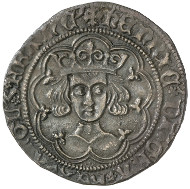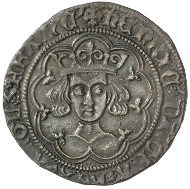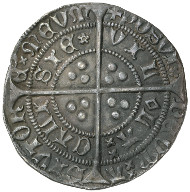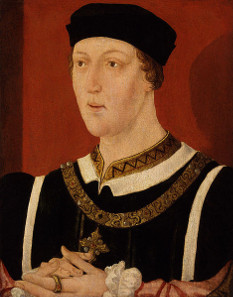Human Faces Part 23: Beginnings of the War of Roses or the idle king
courtesy of the MoneyMuseum, Zurich
translated by Teresa Teklic
Why is it that for centuries – or rather thousands of years – the head has served as the motif for the side of a coin? And why has this changed in the last 200 years? Ursula Kampmann poses these questions in her book ‘MenschenGesichter,’ from which the texts for our new series are taken.
Henry VI, King of England (1422-1461 and 1470/71). Groat (4 Pence), Calais.
Frontal view of King’s head with crown, surrounded by multifoil circle. Rev. Cross on top of two circumscription circles. © MoneyMuseum, Zurich.))
When Henry V of the House of Lancaster died in 1422, he left behind a France almost conquered and a son of just one year of age. Little Henry VI was crowned King of England, but the real power lay in the hands of influential magnates – and that until long after his coming of age.
Power was seductive and all great men in England ardently longed to possess it. And they stopped at nothing to achieve their goal. The king did not intervene to end the violence. He was a powerless observer, who watched the different parties fight each other, his chancellor being murdered, the chancellor’s wife burnt on the stake as a witch, the Bishop of Chichester lynched. Even when Richard of York put forward his claims to the throne, he did not stir. With Henry, the throne was in incapable hands. And Richard, who was actually related a little closer to the now dead Plantagenets, knew how to use the popular discontent in the country to his advantage.
In the Battle of St Albans the rebels, under Richard’s command, defeated those whose power at court dictated the king’s politics. York even took the king, who had been watching the battle from a distance, captive.
Henry VI of England. Portrait, anonymous, c. 1540. Source: Wikicommons.
Five long years Henry was being dragged around by York before Richard expressed his claims to the throne. Neither Lords nor Commons were thrilled about this. However, in the end both parties agreed that instead of dethroning Henry, his son would be disinherited and Richard proclaimed Henry’s successor.
But now Richard had to face a new enemy who turned out to be much more difficult to defeat than Henry had been. The queen adamantly defended her son’s rights. She succeeded in quelling the rebellion and freeing the king after Richard of York had fallen during a skirmish in 1460.
Only her victory didn’t last longer than a year. Then Richard’s son, self-proclaimed king by that time, defeated the queen’s army. The royal family had to flee. Henry hid out in an inhospitable region of Scotland for five years before he was finally taken captive again in 1465 and imprisoned in the Tower of London. Once more the followers of this idle king freed him, once more Henry’s troops were defeated, once more he was taken captive and finally, in May 1471, executed.
So it happened that with his idleness King Henry VI caused the War of Roses and was responsible for more deaths than many a tyrant before and after him.
Next week in CoinsWeekly you can witness how even in the Middle Ages women could sometimes gain political power and influence, when we talk about the history of the abbesses of Zurich.
All sections of the series can be found here.
The book ‘MenschenGesichter’ is available in printed form from the Conzett Verlag website. It soon will be translated to English …











